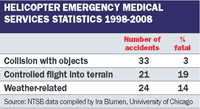Safety technologies are likely to play a key role in combating what US National Transportation Safety Board officials say is an "unacceptable" increase in the accident rate for helicopter emergency medical services (HEMS), a transport mode used to move severely ill patients or donor organs between hospitals or from accident sites. The most deadly year so far in the USA was 2008 for the roughly 835 helicopters serving the US market, with 13 accidents claiming 29 lives.
A comprehensive analysis of data compiled by the University of Chicago Medical Centre shows that the sector experienced three accidents per 100,000 fight hours flown in 2008, with two of every three accidents proving fatal. As a whole, the helicopters averaged 575h flight time and transported 426 patients, says the study.
Not only is the rate higher than in any other general aviation sector, but crews in 2008 would be considered to be in the highest risk occupation for fatal injuries by far when stacked against US Bureau of Labor Statistics metrics for other careers.
 |
|---|
Aside from the statistical proof that there is a problem, public and political pressures have increased in light of high-profile accidents last year, exemplified by the crash of a Maryland State Police HEMS aircraft that hit trees after attempting to divert to an airport with an instrument approach as ceilings and visibility dropped en route from the accident scene to the hospital.
Four were killed, including the pilot, flight paramedic, one local fire department emergency medical technician and one patient. A second patient survived. Although the investigation continues, a prime suspect is controlled flight into terrain.
PREVENTING ACCIDENTS
Experts say technology, among other preventatives, could play a major role in reining in the accident rate. In a seminal special investigation conducted in 2006, the NTSB determined that 29 of the 56 accidents reviewed could have been prevented if recommendations made to the US Federal Aviation Administration as far back as 1988 had been implemented. Included was a plea to equip all HEMS craft with terrain awareness and warning systems (TAWS), an add-on with which the Maryland State Police Eurocopter AS365N1 was not equipped.
T K Kallenbach, vice-president of marketing and programme management for Honeywell Aerospace, says about one-third of the helicopters in the USA have some form of TAWS on board - devices that carry a 3D database of terrain and obstacles 100ft (30m) and higher above the surface and warn pilots of impending collisions both visually on a display and aurally.
 |
|---|
Honeywell builds a helicopter-specific version of its enhanced ground proximity warning system for fixed-wing aircraft. The company's branded TAWS takes into account the low altitude, flight speeds and unique manoeuvrability of helicopters to reduce nuisance alerts and the system is available from $25,000 installed.
For the longer term, Kallenbach says a combination of helicopter EGPWS and helicopter-specific synthetic vision system (SVS) is a more comprehensive solution for situational awareness. Already certificated for high-end business jets, the SVS draws a 3D image of the terrain and obstacle database, overlaid with head-up display-like flight parameters on the primary flight display.
The company had previously tested the technology on a Eurocopter AS350 and is now perfecting the system on its corporate AW139. Honeywell is also researching the use of millimetre-wave radar as a means to identify cables and wires, obstacles not recorded in databases, in real time.
Bell Helicopter, meanwhile, is planning to gain supplemental type certificates for helicopter models in the second or third quarter of this year for a low-cost, non-intrusive, retrofittable video monitoring system that will aid investigations of otherwise non-equipped helicopter accidents and incidents and allow operators to participate in flight operations quality assurance (FOQA) programmes.
 |
|---|
© NTSB |
The 1.8kg (4lb) system uses four cameras mounted behind the pilots to take images of the floor pedals, collective and cyclic controls, instrument panel and the pilot's hands - but not his or her body. It comes complete with an internal global positioning system engine. For playback, Bell uses custom software to merge the pictures from the four cameras into one overall image and plots the flightpath using Google Earth.
Dave Downey, former head of the FAA's rotorcraft directorate and new vice-president of flight safety at Bell Helicopter, says determinations are difficult or impossible to make in 20% of accidents - one in every five - as there is no data available.
"We will be amenable to retrofitting almost anything in the cockpit that gets us past the one-in-five figure," says Downey.
LIGHTWEIGHT RECORDER
Appareo Systems is working with Eurocopter to certificate in 2010 a lightweight flight data recorder for its popular AS350B2 and AS350B3 light single-turbine helicopters. The prototype unit, which weighs only 300g (10.6oz), will include cockpit imaging and sound recording capabilities and is projected to cost less than $10,000, says Dave Batcheller, director of quality, process and programme management at North Dakota-based Appareo.
With its own internal micromechanical gyros and accelerometers, the Vision 1000 is platform-agnostic, says Batcheller, and software applications, developed with the Bristow Group, will allow operators to use data for FOQA programmes.
Batcheller says product development with Eurocopter is "well under way", with the STC on schedule to be complete in the third of fourth quarter this year and forward-fit installations on new helicopters as standard equipment starting in 2010.
Appareo has seen marked behavioural changes when its existing data recorder products have been installed on helicopters, a finding early adopters of helicopter FOQA systems also saw in the North Sea trials in the late 1990s.
According to Batcheller, one operator noted a 95% drop (from more than 500 a month down to about 10) in the incidents of pilots flying below standard operating procedure altitudes within six months of having the recorders installed. "It was a profound reduction in risk," he says.
Source: Flight International
















